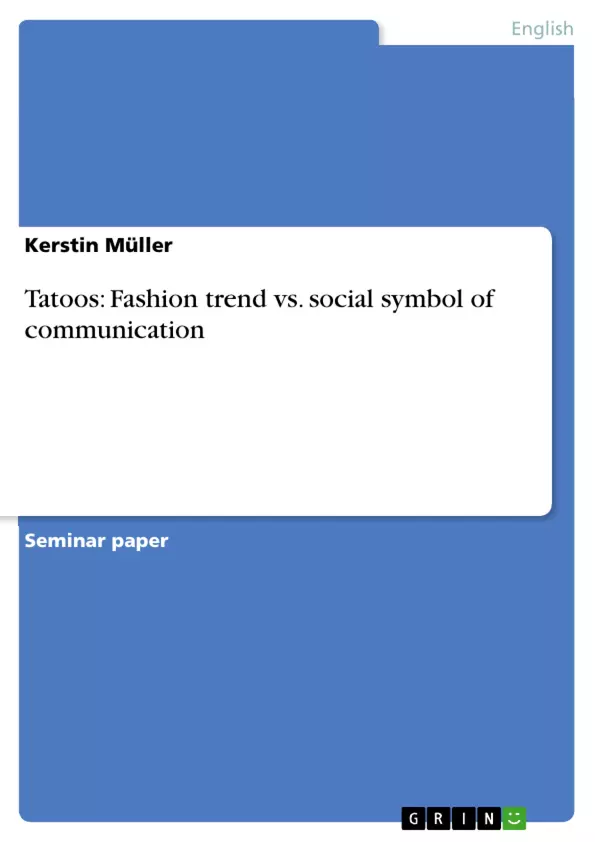In 1997, the Hartford Courant published the research results of the American Economic Information Service concerning those economic branches which have shown the highest rates of expansion in 1996. Among expected high-tech branches such as the Internet, for example, one branch, which had up to that point not even been regarded as an economic branch, appeared among first six ranks: the tattoo- ind ustry (Stirn 285). This example clearly shows that tattooing has intensely increased in popularity towards the end of the 20 th century. Tattooing is no longer a rarity, but is present in everyday life. Tattoos can be detected on various kinds of parts on the human body, and the motives appear in uncountable varieties of shape and design, with colours ranging from plain black to gaudy. Tattoos are especially popular among younger people between the age of 15 and 25. In general, the numbers range from seven to twenty million tattooed individuals for the United States, and state about two million for Germany (Stirn 285). These numbers are generally only rough estimations, because there is no reliable method of counting, and the results mainly rely upon accounts of recently developing tattoo associations. The focus of this paper shall lie on the function of the tattoo, namely whether or not the tattoo is just an ephemeral fashion trend or a lasting constituent of the human culture. It shall be analysed in what way tattooing can be regarded as fashion and to what degree it can be considered to be a social symbol in human interaction. First, a general history of tattooing shall be given, because the development is important for the comparison. In order to avoid obscurities concerning the term tattoo or tattooing a short definition shall be given here. According to Finke, several authors differ in their definition of tattoos. Some sources use tattooing as a general topic including all kinds of body modification, such as branding, scarification and body painting (Finke 15-17). In the course of this paper, the term tattoo shall only be used to describe the pemanent embedding of pigments into the skin, excluding scarification, body painting and branding. a The given definition excludes all other forms of body alteration but raises the need to differentiate further. There are tattoos which have not been obtained voluntarily, so-called compulsive tattoos which have been put on prisoners or soldiers throughout history. [...]
Table of Contents
- Introduction
- Cultural Tattoo History
- Tattoos regarding Fashion and its role in society
- Social symbols in human interaction
- The meaning and function of tattoos
- Signs of affiliation and initiation
- Tattoos as a requirement for admittance
- Tattoos as a voluntary aspect of group admittance
- Distinction and exclusiveness
- Signs of affiliation and initiation
- Conclusion
Objectives and Key Themes
The main objective of this paper is to analyze the function of tattoos, examining whether they represent a fleeting fashion trend or a permanent aspect of human culture. The paper investigates the connection between tattooing and fashion, exploring how tattoos can be considered both fashionable and symbolic within human interactions.
- The historical development of tattooing and its cultural significance
- The relationship between tattoos and fashion trends
- The role of tattoos as social symbols in human interaction
- The various meanings and functions of tattoos, particularly as signs of affiliation and distinction
- The evolution of tattooing from a rare and exclusive practice to a more widespread phenomenon.
Chapter Summaries
The paper begins with an introduction that highlights the rapid increase in tattooing's popularity towards the end of the 20th century. It then provides a clear definition of "tattoo" and clarifies the scope of the analysis, excluding compulsive and accidental tattoos.
Chapter 2, "Cultural Tattoo History," delves into the historical roots of tattooing, tracing its presence across various cultures and eras. It highlights the importance of understanding the historical development of this art form to appreciate its cultural constituents. The chapter discusses the prevalence of tattooing in ancient civilizations, such as Egypt and Europe, and explores its resurgence in the 18th century, largely influenced by travelers' encounters with tattooed individuals from the Pacific islands.
Chapter 3, "Tattoos regarding Fashion and its role in society," explores the relationship between tattooing and fashion. It examines how tattooing has evolved from an exclusive practice associated with certain social groups (such as sailors and aristocrats) to a more widely accepted form of self-expression. This chapter discusses the role of social and cultural factors in shaping the perception of tattoos and their connection to fashion trends.
Chapter 4, "Social symbols in human interaction," examines the role of tattoos as symbols within human interactions. This chapter explores the various ways in which tattoos can convey messages, affiliations, and social identities. It delves into the specific meaning and function of tattoos as signs of affiliation and initiation, analyzing how they serve as markers of group membership and personal identity.
Chapter 5, "The meaning and function of tattoos," focuses on the diverse meanings and functions attributed to tattoos. This chapter explores the ways in which tattoos can function as signs of affiliation, initiation, and distinction. It examines different types of tattoos, including those acquired voluntarily as part of group identity and those used to signify personal beliefs or experiences.
Keywords
The primary focus of this paper is on the cultural significance of tattoos, specifically their role as both a fashion trend and a social symbol of communication. Key themes include tattoo history, cultural anthropology, fashion, social interaction, symbolic meaning, affiliation, initiation, distinction, and the evolving nature of tattooing in modern society. These concepts are explored through historical accounts, ethnographic observations, and discussions of the various functions and interpretations of tattoos.
- Citation du texte
- Kerstin Müller (Auteur), 2002, Tatoos: Fashion trend vs. social symbol of communication, Munich, GRIN Verlag, https://www.grin.com/document/29991



